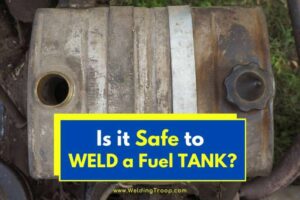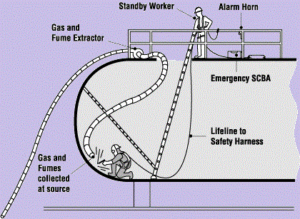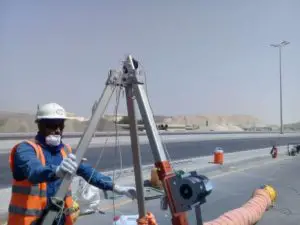Free Online Confined Space Training
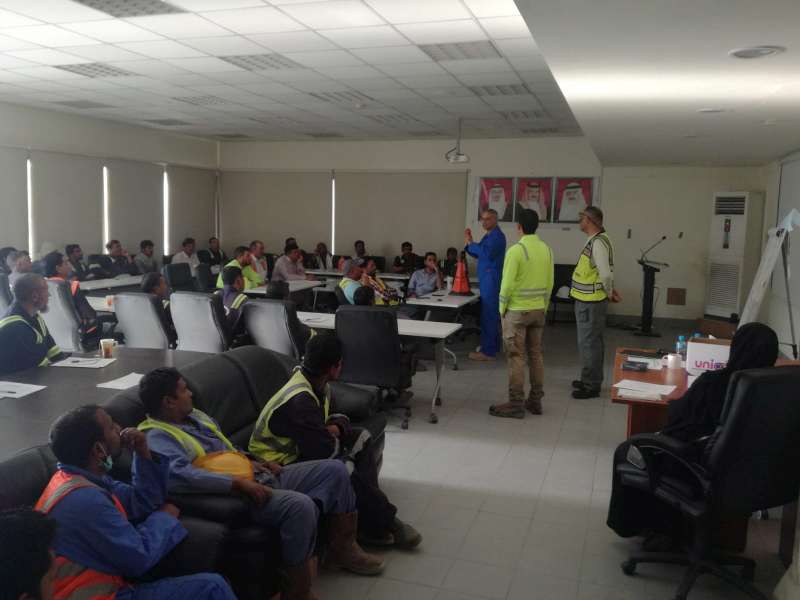
Confined space training is a very important matter in the case of confined space works, confined space works are the most critical and dangerous works in their nature. thousands of workers died every year due to accidents related to confined spaces. The most common cause of the confined space accidents is lack of training and lack of knowledge. This article is mainly discussing all the required topics for confined space training. Training must be done by a competent trainer and an approved training institute. in most countries, these types of critical training are only given by the authorized trainer and authorized institutes by the Ministry of Labor.
Introduction
1. Dangers of Confined Spaces
1.1. Dangers of Confined Spaces
1.1.1. What is a Confined Space?
1.1.2. Temporary Confined Spaces
1.1.3. Flammable Atmospheres
1.1.4.Hazardous Temperatures – HOT
1.1.5. Hazardous Temperatures – COLD
1.1.6. Hazardous Atmospheres
1.1.7. Oxygen-deficient Atmosphere
1.1.8. Toxic Atmospheres
1.1.9. Drowning
1.1.10. Asphyxiation
1.1.11. Configuration Hazards
1.1.12. Dangers
1.1.13. Hazardous Tasks
1.1.14. How are you doing?
2. Legal Duties and Responsibilities
2.1. Legal Duties and Responsibilities
2.1.1. Assessing the Risks
2.1.2. Confined Spaces Regulations
2.1.3. Avoid Entry
2.1.4. Safe System of Work
2.1.5. Is a Permit Required?
2.1.6. Permit to Work
2.1.7. Hot Work Permit
2.1.8. Supervisor
2.1.9. People Entering a Confined Space
2.1.10. Standby Personnel
2.1.11. Rescue Personnel
2.1.12. Arrangements for Emergency Rescue
2.1.13. How are you doing?
3. Preparing for Entry
3.1. Preparing for Entry
3.1.1. Just to Check!
3.1.2. Testing the Atmosphere
3.1.3. Failure of Test Results
3.1.4. Purging
3.1.5. Ventilation
3.1.6. Isolation
3.1.7. Cleaning
3.1.8. Lighting
3.1.9. Protective Equipment
3.1.10. Personal Protective Equipment
3.1.11. Respiratory Protective Equipment
3.1.12. Using RPE
3.1.13. How are you doing?
3.1.14. Conclusion
Test
Question
When working in a cold environment, if a person becomes dizzy, nauseous, and has pain in their hands, feet, nose or ears, they may be showing symptoms of what?
Please choose from the following options
• A. Hypothermia
• B. Hypertension
• C. Hypoglycaemia
Question
Disturbing sludge can release dangerous gas, fumes or vapours.
Please choose from the following options
• A.True
• B.False
Question
So long as a confined space is sufficiently ventilated prior to entry, there is no need to ventilate whilst work is being carried out
Please choose from the following options
• A.False
• B.True
Question
The permit-to-work system involves formally checking the safe system of work before anyone enters a confined space
Please choose from the following options
• A.False
• B.True
1. Dangers of Confined Spaces
1.1. Dangers of Confined Spaces
1.1.1. What is a Confined Space?
1.1.2. Temporary Confined Spaces
1.1.3. Flammable Atmospheres
1.1.4. Hazardous Temperatures – HOT
Whether it’s hot or cold, extreme temperatures can be dangerous. and this can be made worse when you are wearing personal protective equipment. In very HOT environments, your body loses water and salt by sweating, so drink an average of 1 litre of fluid each hour to stay hydrated. Drinking water should be freely available, and you must drink every quarter-hour or so – even if you don’t FEEL thirsty. NEVER drink alcohol in hot environments – it only dehydrates you faster. To reduce the risks in a hot environment, avoid scheduling work during the hottest part of the day, and give workers extra breaks to rest and drink. People’s reactions to heat can be unpredictable. Workers must keep an eye on each other’s well-being in high temperatures.
1.1.5. Hazardous Temperatures – COLD
In very COLD environments, you could get frozen skin, fingers, toes, nose and earlobes. Or your body temperature could fall dangerously low. If anyone in a cold environment complains of:
• Dizziness
• Nausea
• Severe shivering
• Exhaustion
• Pain in their hands, feet, nose or ears Or is unusually irritable or excited, they may have hypothermia. Move them to a warm place and get medical help – hypothermia can kill.
1.1.6. Hazardous Atmospheres
Air doesn’t move freely through confined spaces, so the atmosphere inside can be different to the air outside. It may be low in oxygen, or it could be so oxygen-rich that it becomes highly flammable, or it may include toxic gases that build up because of the lack of ventilation. In a confined space, a lack of natural ventilation can make the atmosphere dangerous. It may become:
• Oxygen-deficient
• Flammable, or Toxic
1.1.7. Oxygen-deficient Atmosphere
Lack of oxygen is the most dangerous hazard in confined spaces. It can kill quickly.
Normal air is 20.9% oxygen.
At less than 19.5%, your heartbeat speeds up.
At 16%, you struggle to breathe and your judgement is impaired.
At 14%, you’re exhausted and sick.
At 11%, you lose consciousness, and
At less than 6% oxygen, death can happen in minutes.
your judgement may be so impaired that you’re unable to save yourself.
Causes of low oxygen levels include:
• Hot Works
• Chemical reactions
• Bacterial fermentation
• Nitrogen or inert gases displacing the oxygen
• Exhaust fumes building up
• Other gases diluting the oxygen, or too many people working in a confined space, breathing the available oxygen In high-risk confined spaces, use a portable oxygen meter with an audio alarm to monitor oxygen levels.
1.1.8. Toxic Atmospheres
Conditions inside or outside a confined space can create a poisonous atmosphere, for example:
- The exhaust from machinery or vehicles
- Solvents, adhesives and degreasing agents
- Welding, acid cleaning and spray painting
- By-products from manufacturing processes
Chemical residues or sludges
- Leakage from pipes, machinery, or contaminated land
- Bacteria or fungi
- Sewage, or animal or bird droppings
- And chemical reactions, fires or explosions
Toxic substances can be fast-acting or long-term poisons. They may enter the body through the lungs, the mouth or even through the skin.
1.1.9. Drowning
• If liquid gets into the confined space, then there is the chance of drowning. It doesn’t have to be a lot of liquid or fill the space – drowning can occur even in a relatively small depth of liquid. There are other dangers with liquids – they may be corrosive or toxic.
1.1.10. Asphyxiation
• You can be engulfed or suffocated by a high concentration of fine particles or loose granules anything in granular or powder form – such as sand, flour, coal, dust or grain. These can get into your mouth and nose and prevent you from breathing. You can also be in danger if a large solid object blocks the air from getting into the confined space.
1.1.11. Configuration Hazards
• The shape of a confined space may be inherently dangerous. If it’s designed to hold liquid or free-flowing solids, entrances and exits may be narrow, and the floors and walls may slope or curve. The measurements and layout of the space must be considered in a risk assessment. There’s a risk of injury on uneven surfaces, and isolated or low-lying sections of the space may have poorer air quality. But the BIG risk is that liquids or small solid granules could drown or suffocate a worker.
1.1.12. Dangers
• Some of these dangers may already be present; some can be created by work in or near the confined space. Other dangers might include:
• Using machinery that needs special precautions in enclosed spaces, for example, to prevent electric shock or dust build-up Gases, fumes or vapours from welding or using solvents or adhesives Objects falling from above – falling objects cause injuries, particularly in open-top spaces, Collapsing structures, Difficulty of access for escape or rescue and Wet surfaces may cause slips and falls, or electric shocks
1.1.13. Hazardous Tasks
Many kinds of work involve extra hazards in or near confined spaces: EXCAVATION can be hazardous because of gases, which can build up from exhaust fumes or be released from soil when it rains.
• Excavation trenches also involve a risk of trench walls collapsing or objects falling from a height. WELDING on any coated surface creates gases that may be toxic.
• Gases can enter a confined space from hot work being done nearby;
• NON-DESTRUCTIVE TESTING (NDT) OPERATIONS can involve a chemical hazard.
• Any hazardous particles build up in confined spaces, increasing the danger. For example:
• SPRAY COATING leaves small particles in the air, which can be highly toxic
• GRINDING creates dust that can cause bronchitis and metal fume fever
• SANDBLASTING uses grits with ingredients that can cause cancer;
• or HYDRO BLASTING creates tiny particles that can get deep into your lungs
• It may be necessary to isolate the confined space so that outside hazards don’t affect it, for example, energy or by-products from nearby processes and machinery.
• This could be liquids, raw materials, carbon monoxide – anything which could seep from outside into the confined space.
1.1.14. How are you doing?
Question
At what point would you lose consciousness?
• A. Air containing 20.9% oxygen
• B. Air containing 11% oxygen
• C. Air containing 14% oxygen
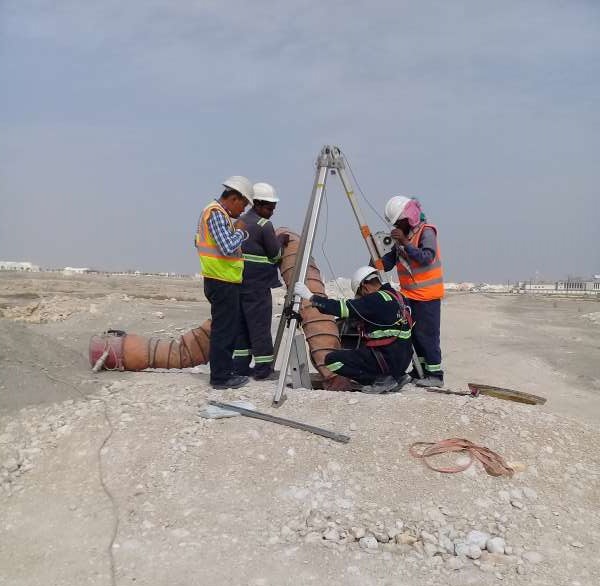
2. Legal Duties and Responsibilities
2.1. Legal Duties and Responsibilities
• Nobody should ever enter a confined space without backup.
• There should always be someone to check your safety, such as a supervisor or standby personnel. There should always be a rescue plan ready in case of an emergency situation.
• The emergency rescue plan should be appropriate to the level of risk in that particular confined space, which is affected by the size of the space and what’s being done in that space.
• It should include the relevant first-aid equipment, such as resuscitation equipment if it might be needed.
• In this section we look at responsibilities and the Law, safe systems of work, risk assessments and work permits.
2.1.1. Assessing the Risks
The Health and Safety at Work Act covers all employers and workplaces and requires that employers have a duty to protect employees and members of the public. And law health & safety at work says employers must make sure a risk assessment is done by a competent person – identifying the hazards, assessing the risks and deciding what precautions to take.
For a confined space, risk assessment will include:
• Whether the entry is unavoidable
• The task
• The working environment
• Its previous contents
• Any residues or contamination
• Oxygen levels
• Physical measurements
• Working materials and tools
• The suitability of the workers for the task
• The control measures that will reduce the risk, and
• The emergency rescue plan
2.1.2. Confined Spaces Regulations
• The Confined Spaces Regulations say that if your risk assessment finds a risk of serious injury, you must:
• Avoid entry if possible
• If you must enter, you MUST follow a safe system of work, and Make emergency arrangements
2.1.3. Avoid Entry
• Avoid entry to a confined space means you should look for ways to do the work without entering confined spaces.
• For example, could the design of the space or structure be changed?
• Or could remote tools and cameras, or long-handled tools be used?
2.1.4. Safe System of Work
If the entry into the confined space cannot be avoided then you must plan a Safe System of Work based on your risk assessment. A Safe System includes these steps:
• Appoint a supervisor
• Make arrangements for communications, standby personnel and alarms
• Prepare a permit to work, if required
Make sure workers are trained, experienced, and physically and psychologically fit for the task
• Check that tools are suitable and safe for the job
• Isolate the workspace from outside contamination
• Isolate the workspace from ignition sources
• Assess entry and exit paths, including for escape or rescue
• Clean and purge the space before workers enter
• Test and monitor the atmosphere inside the confined space
• Provide ventilation and air supplies during the work or for emergencies
• Make sure breathing equipment, PPE and rescue harnesses are available, if required;
• and Keep entry and exit records and a tally of workers in the confined space
2.1.5. Is a Permit Required?
• Not all confined spaces require a permit for entry.
• Spaces that require a permit must have signs outside them saying so.
• Permits are required to enter spaces with serious health and safety hazards including:
• Oxygen-deficient atmospheres
• Flammable atmospheres
• Toxic atmospheres
• Physical, mechanical or electrical hazards,
• or Lose materials that could trap or cover workers
2.1.6. Permit to Work
The permit-to-work system involves formally checking the safe system of work before anyone enters a confined space.
It does NOT, by itself, make the workplace safe. But it confirms that hazards and risks have been assessed, controls are in place, and the work can go ahead. A permit-to-work should include:
• Site location
• Reason for entry
• Description of the job
• Roles and responsibilities of everyone involved, including contractors
• Space classification, if it’s a classified space
• Environmental conditions and test results
• Types of hazardous processes
• How hazardous energy sources are isolated
• PPE required
• Training required
• Physical fitness required
• Communication systems used
• Rescue procedures and equipment
• Checks of contractor permits, procedures and training
• Entry date and length of the project
• Signature of the authorising person and Signatures of the workers
Make sure the requirements of the permit are clear, and all the safety specifications are followed.
When the work’s finished, the authorising person cancels the permit. If the permit expires before the work’s finished, conditions must be re-inspected before a new permit is issued. Deciding not to use a permit-to-work system is a serious matter. This decision must only be made by a competent person, taking into account the risk assessment and any specialist advice.
2.1.7. Hot Work Permit
• For temporary work that creates heat, sparks or flames, for example cutting, grinding or welding, you need a separate hot work permit. This is a formal checklist of potential safety issues and a confirmation that the work can go ahead.
2.1.8. Supervisor
• Anyone entering a confined space must have a suitably trained, competent supervisor.
• The supervisor’s first duty is to eliminate the need for entry into confined spaces.
• If it’s unavoidable, the supervisor conducts a risk assessment and develops a safe system of work.
• The supervisor provides a confined space entry permit
• when the requirements are met and safety measures are in place.
• Based on the risk assessment, they may spot-check or supervise to make sure the safe system of work is followed.
2.1.9. People Entering a Confined Space
• Nobody should enter a confined space unless they’re trained and authorised, and only under the conditions of the entry permit.
• They must be physically and psychologically fit for the task, before entering, they must get instructions from the supervisor or standby person about specific hazards and precautions and the emergency rescue plan. They must tell their supervisor about:
• Any flaws they’ve noticed in the system of work,
• and Any accidents, near misses, or equipment faults
2.1.10. Stand by Personnel
• For confined space work with a permit, a standby person must stay OUTSIDE and communicate regularly with the entry team.
• If a worker is injured or unconscious, the standby person will notice and call for help.
• The standby person must:
• NOT work on any other task at the same time
• NOT leave their post for any reason unless they are replaced by another standby person
• STAY close to the entrance
• Be in constant CONTACT with workers inside the space and monitor their wellbeing
• Call for HELP in an emergency
• Keep RECORDS of who enters and leaves the space, and PREVENT unauthorised people entering the space
• They may also:
• Operate safety equipment and monitor environmental conditions
• Call off the entry when the operation is finished or if conditions change
• Order an immediate evacuation in an emergency; and
• Start emergency procedures and help with rescue operations,
• WITHOUT entering the confined space
2.1.11. Rescue Personnel
• It’s hard to escape from a confined space in an emergency, and it’s hard for rescue personnel to get in and out too. Rescue personnel must be trained in rescue, CPR and first aid, as well as taking precautions for their own safety.
2.1.12. Arrangements for Emergency Rescue
Before anyone enters a confined space, make sure they can be rescued safely if something goes wrong. Emergency arrangements must include:
• A way for workers in the confined space to raise the alarm if there’s a problem
• Standby personnel and attendants
• PPE, first aid, rescue and resuscitation equipment
• Keeping rescue personnel safe from the hazards of the confined space and the emergency
• Planning how to contact emergency services.
• For high-risk, longer-term work in confined spaces, talk to the emergency services before work begins Making sure on-site rescue personnel are adequately trained, and testing and drills of the arrangements
2.1.13. How are you doing?
Question
The standby person must…
• A. Enter the confined space to observe the worker
• B. Stay close to the entrance of the confined space and be in constant contact
• C. Stay close to the entrance of the confined space and check-in from time to time
3. Preparing for Entry
3.1. Preparing for Entry
• So, now you know the potential dangers of working in a confined space and you know the importance of following your safe system of work. The final thing you need to know about before you work in a confined space is the safety tests. In this section, we look at how you test the atmosphere and we look at PPE and RPE.
3.1.1. Just to Check!
• The first thing you must do is be sure that you HAVE TO enter the confined space,
• the first question is can you AVOID entering the confined space?
• If not, has a risk assessment been carried out?
• Has the space been inspected?
• Is the atmosphere safe?
• Is the temperature safe?
• Has the space been cleaned and purged?
• Will any nearby work affect conditions inside the space?
• Is the entrance big enough for workers with PPE and other equipment?
• And, Is there a confined space entry permit system?
3.1.2. Testing the Atmosphere
• Before workers enter a confined space, the air must be tested and the results noted in the permit to work, along with any special safety measures required. There are 3 main tests which have to be done:
• Testing Oxygen levels
• Testing Flammability, and
• Testing Toxicity
• You should re-test a confined space if you leave it,
• even if only for a short time, before you re-enter it.
• You need to make sure you:
• If the space is being ventilated, stop the ventilation at least 10 minutes before testing.
• Disturb any sludges to release trapped vapours and gases before testing.
• Test oxygen levels first, then flammability, then toxicity.
• Some gases or vapours are heavier or lighter than air, so test at the top, middle and bottom of the space.
• Test in hard-to-reach areas where gases and contaminants might build up.
• While you’re testing, avoid standing directly over the opening, and don’t let the wind blow the atmosphere from inside the space toward you; And, If testing reveals a hazardous atmosphere, ventilate and re-test.
• Your body can’t sense oxygen levels, and many toxic gases have no colour or smell.
• Never assume the air is safe until it’s been thoroughly tested.
3.1.3. Failure of Test Results
• If the air becomes unsafe while you are working in a confined space, your life may depend on what you do next.
• You must respond quickly and correctly.
• If the alarms on your testing equipment go off or if tests show the air has become unsafe,
• If the air may have become flammable STOP all work at once and GET OUT.
• If the toxicity levels have gone too high GET OUT.
• You then need to find out what may have caused the danger, control it and then RE-TEST the atmosphere before going back into the confined space
• You should never assume that the air in a confined space is safe.
• It MUST always be tested.
3.1.4. Purging
• Purging means using a stable gas to flush a hazardous atmosphere out of a confined space.
• Purging pushes out any breathable air, too, so the space must be ventilated after purging.
3.1.5. Ventilation
• A confined space may need ventilation before entry AND while work is being carried out.
• There are 2 types of ventilation: extraction, and forced.
• Extraction ventilation sucks contaminated air out,
• but this isn’t enough if the contamination is widespread.
• And, forced ventilation involves pushing fresh air – NEVER use pure oxygen – into the confined space.
• Ventilating a flammable environment may actually increase the risk of fire or explosion, so use flameproof ventilation equipment.
• Position ventilation openings so that the whole space is ventilated, and contaminated air doesn’t get carried back inside.
• Put air supply and extraction ducts as far apart as possible and add extra openings if necessary.
• In deep spaces, bring in the fresh air at the bottom and extract contaminated air at the top.
• Always test the atmosphere after ventilating or purging, and BEFORE entering.
3.1.6. Isolation
• Isolation of a confined space means temporarily cutting it off from outside energy and materials.
• The supervisor should assess whether this is necessary before anybody enters the space.
• Isolation can include:
• Locking out electrical sources
• Keeping out heat or cold
• Disconnecting linkages on shaft-driven equipment
• Using latches, blocks and other ways to hold moving parts
• Blanking off or removing sections of pipework, or
• Sealing the space against pressure or vacuum
• Notices must be displayed showing the agreed isolation requirements.
3.1.7. Cleaning
• Cleaning may be necessary to stop fumes developing from hazardous residues
• while workers are inside a confined space.
• The space must also be clean enough to show any corrosion or structural damage.
3.1.8. Lighting
• Use natural lighting whenever possible, but you may need to bring cabled or portable lighting into a confined space.
• Inflammable or explosive atmospheres, use specially protected lighting.
• In electrically conductive environments, use extra-low voltage equipment, and residual current devices if necessary; and always carry a small BACKUP LIGHT in case the main lighting goes out or is obscured.
3.1.9. Protective Equipment
• The risk assessment and permit to work will detail the hazards and risks of the job,
• and what Personal Protective Equipment (PPE)
• The PPE and RPE mustn’t be so bulky they make getting through entrances and exit difficult.
3.1.10. Personal Protective Equipment
• All other control measures must be implemented first, if possible,
• but for someone entering a confined space,
• Personal Protective Equipment or PPE may be the first line of protection.
• The PPE provided must be based on the risk assessment.
• It can include:
• Body protection, such as overalls
• Foot protection, for example, steel inserts or high-grip soles
• Hand protection, such as gloves
• Eye protection, for example, goggles
• Ear protection, such as earplugs or ear covers – as long as they don’t prevent vital communication
• Gas meters or automatic testing devices for monitoring the local atmosphere
• Handheld lighting
• A body harness, and A personal movement alarm that goes off if a worker doesn’t move for a length of time, suggesting they may be injured or unconscious
3.1.11. Respiratory Protective Equipment
• If atmospheric hazards can’t be eliminated or controlled, employers must provide adequate breathing equipment – and training in how to use it. Respiratory Protective Equipment, or RPE,
• stops workers breathing too much dangerous dust or gas.
• Some RPE also provides oxygen.
• You have to choose the right type of RPE for the conditions.
• There are 2 types of respirators: air FILTERING and air SUPPLYING.
• Air SUPPLYING respirators deliver air either via a hose from outside or from a self-contained breathing apparatus the worker carries with them.
• Hoses supply air continuously, but can hamper movement
• Self-contained breathing apparatus, or SCBA,
• carries a limited store of air and is bulky to wear, and SCBA is required for rescues and as a backup to airlines in high-risk environments
• Air FILTERING respirators catch contaminants in the air so they aren’t breathed in.
• They contain a cartridge with a chemical filter inside that must be exactly the right type for the atmosphere.
• Some filter solid particles
• Some filter gases and vapours
• And some filter solids, gases and vapours
• They do NOT provide oxygen or air.
• It’s important to replace cartridges regularly or they will stop working.
3.1.12. Using RPE
• The facepiece of a respirator must form an UNBROKEN SEAL
• with the skin to prevent contaminated air from getting in.
• When you inhale, air comes into the facepiece from the air inlet,
• but a badly-fitting negative pressure respirator may let contaminated air in too.
• Positive pressure respirators pump air into the facepiece, forcing air out of any leaks and preventing contaminated air from entering the facepiece.
• Before using an airline or self-contained breathing apparatus (SCBA), users must be trained, competent, physically fit and the equipment must fit properly.
• All equipment – unless it’s disposable – has to be cleaned, disinfected and inspected before it can be used again, and must be stored correctly.
• Cartridges and filters must be replaced whenever necessary.
• Follow the manufacturers’ recommendations.
3.1.13. How are you doing?
Question
If the air becomes unsafe while you are working in a confined space, firstly…
• A. Call your supervisor
• B. Re-test it.
• C. Get out
3.1.14. Conclusion
• Thank you for this article on working in confined spaces.
• You should now know the potential dangers when working in confined spaces and understand how to keep yourself and others safe by doing the appropriate tests, following safe systems of work, using PPE and RPE and ensuring you know your organisation’s emergency procedures.
• This article concentrates on safety; it does NOT replace practical training.
• A confined space is any place that’s largely or completely enclosed:
• It may have limited openings for entry and exit or have entries and exits in problematic places.
• This makes it harder to get people or equipment in or out,
• including during emergency rescue situations;
• It may have poor natural ventilation; and It may not be designed for continuous use by workers. Most confined spaces were never meant to have people inside them often, or for long periods.
• They weren’t designed for human comfort, so anyone entering a confined space may face hazards and risks. And it’s these confined spaces that we are interested in – the ones which present one or more of the following dangers to you or the person or people working in them:
• Flammable atmospheres: which could cause serious injury due to fire or explosion
• Hazardous temperatures: which could cause loss of consciousness due to increased body temperature
• Hazardous atmospheres: which could cause loss of consciousness due to toxic gases, fumes, vapours or lack of oxygen
• Drowning due to an increase: in the level of a liquid, or
• Asphyxiation: due to free-flowing loose particles preventing breathing –
• loose granules such as sand or grain can engulf and suffocate a person
• Some places are only confined spaces during specific times or events,
• for example, while they’re being built or repaired.
• And some confined spaces are only dangerous at certain times, for example when hazardous materials are used or stored inside.
• Confined spaces can be cramped and dark.
Movement may be limited and getting in or out may take time, so people who suffer from claustrophobia, panic or anxiety attacks should not enter confined spaces. Noise can be amplified in confined spaces, causing hearing damage or making it harder to communicate. A fire or explosion requires oxygen, fuel and a source of heat. Removing one of these three things is usually enough to control the risk. In a confined space, certain concentrations of gases, vapours or dust can make the air flammable. Oxygen levels above 22% create an extremely flammable atmosphere and above 23.5% it’s potentially explosive, so never use pure oxygen to ventilate a confined space.
Methane levels between 4.4% and 17% are potentially explosive. And other causes of flammable atmospheres include dust, flour, solvents, paint spray, and chemical reactions or leaks. It’s really important to make sure equipment used in flammable atmospheres is safe and that fire extinguisher are provided. Static electricity can start fires, so earthing may be necessary to prevent it.
